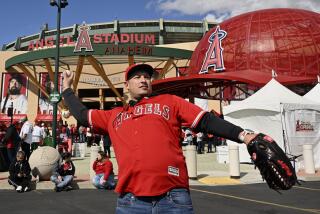It’s Been 70 Years Since Anaheim Booted Klan
- Share via
ANAHEIM — When the city’s three new council members are sworn in on Tuesday, they will be a part of the biggest turnover on the panel since 1925.
But the current revamping is taking place under vastly different circumstances than 70 years ago, when Anaheim experienced the worst political turmoil in its history.
It was during that time that four members of the Ku Klux Klan were forced off of the City Council (then known as the Board of Trustees) in a recall election. The four men had been elected in 1924 as part of a slate secretly sponsored by the Klan and had served for 11 months, according to newspaper accounts.
“It really was a rough time in the city’s history,” said 82-year-old Anaheim resident Elizabeth Schultz, whose uncle was head of the city’s water department during that era.
“I remember my uncle telling me that his employees had to carry shotguns in the streets for protection because the city was so divided over the klan,” Schultz said.
After they were elected to the panel, the klavern’s presence in city government was quickly evident. The letters KIGY--for Klansman I Greet You--were painted on major streets entering town to assure visiting KKK members that they were on friendly turf.
The Anaheim klavern concentrated much of its efforts into politics. Since there were few minorities living in Anaheim at that time, the klan was limited to opposing Catholicism and bootlegging, both of which were plentiful in Anaheim.
“It was more of a religious thing,” said 82-year-old Lecil Slaback of Silverado Canyon, whose uncle, Aaron A. Slaback, was among the klansmen ousted from the council.
“He was not a racist,” Slaback said of his uncle, who ran a grocery store downtown. “He was a kindly, pleasant man and very soft-spoken. All of this was just part of politics.”
Aaron Slaback was among the local residents who apparently were influenced by the Rev. Leon C. Myers, who arrived in the city in 1922 to lead the First Christian Church of Anaheim, which provided a major boost for the klan.
Myers formed a men’s Bible study group, which became the foundation for the klan in the city, and he used his pulpit to push membership.
During the height of their power, the Ku Klux Klan had an estimated 300 members in Anaheim out of a population of about 10,000. They patrolled city streets in their robes and masks, stopping and interrogating citizens, and once burned a large cross in front of St. Boniface Roman Catholic Church.
Anaheim was being advertised as a model klan city and was selected as the sight of a huge KKK rally that attracted about 20,000 people from all over California.
It was at this point that opponents became more determined than ever to rid the city of the klan, and hostility between the two forces reached a new high.
Anti-klan residents had formed a group called USA Club--for “Unison, Service, Americanism”--and backed a slate of successful candidates in the statewide primaries of 1924. This would be the first of several major blows dealt to the klan by the USA Club.
The City Council then went under attack for ordering the removal of a flag and flagpole from the main intersection in town. This furor escalated when a leader of the anti-klan forces bought a membership list of the local klavern.
The list, which was distributed throughout the town, included the names of the four councilmen, nine of the 10 members of the Police Department and several other city officials.
Soon after, recall petitions against the four councilmen were circulated.
The bitter battle pitted Anaheim’s leading newspaper, the Plain Dealer, which supported the Klan’s candidates, against the Anaheim Bulletin and the Anaheim Gazette.
On the day of the recall election in February, 1925, 95% of the city’s registered voters turned out at the polls, which were guarded by city police, sheriff’s deputies and district attorney inspectors.
The klan suffered a resounding defeat with each councilman losing by more than 500 votes. At the same time, the klan’s attempt to recall the lone anti-klan councilman failed.
More to Read
Sign up for Essential California
The most important California stories and recommendations in your inbox every morning.
You may occasionally receive promotional content from the Los Angeles Times.










